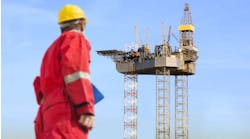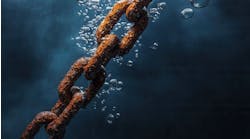Noble Drilling finds success with Terresolve hydraulic fluid
To be more environmentally responsible, Noble Drilling has been looking for a non-toxic hydraulic fluid for use in the exposed areas on its rigs. Noble experienced what many drilling contractors experience when searching for bio-based alternatives – synthetic ester-based, environmentally-safe fluid hydrolyzes (breaks down) when contaminated with water. Hydrolysis “unzips” the ester molecule and forms acids and unstable triglycerides, which are subject to oxidation (breakdown due to heat).
Finding the right partner
Noble found Terresolve Technologies, an industry leader in producing readily biodegradable lubricants and functional fluids. The company has serviced the offshore market for more than a decade with high performance non-ester-based, non-toxic fluids. Before launching a field trial, Noble consulted with the National Oilwell Varco (NOV) Lifting Systems group, which agreed to support the trial provided that Linde Pumps (the maker of the hydraulic pumps used in Noble cranes) approved of the fluid. To approve the trial, Linde required approval from the Verband Deutscher Maschinenund Anlagenbau–German Engineering Federation. The VDMA is one of the key association service providers in Europe and offers the largest engineering industry network.
Linde Pumps employees worked with the VDMA to develop a meaningful test for mineral oils and biodegradable fluids. They developed a screening method capable of establishing the correlation between field experience and the results of an accelerated test now known as the Linde Test or VDMA 24570.
Testing fluid offshore
After Terresolve Technologies' EnviroLogic hydraulic fluid passed the test, Linde and NOV approved the fluid for testing offshore. Noble selected five cranes on three rigs: theNoble Tom Jobe, the Noble Johnnie Hoffman, and the Noble John Sandifer. Each system was drained of the previous fluid and then flushed to remove residual byproducts of hydrolysis and oxidation. The reservoirs were hand cleaned, and the systems were recharged with Terresolve EnviroLogic 3068.
Samples were taken prior to the change out, after the flush and after the final fill. Ongoing, in-service samples were taken each month and the results were analyzed by all parties. Although the test is complete, the analysis is ongoing. While in any oil analysis program there is room for aberrant data points, the trend and surrounding data help in the interpretation of the results. This test focused on the oil testing typical of any lubricant. The key metrics measured were the total acid number, the viscosity and the phosphorus level. Wear metals, water, fuel and external lubricant contamination, corrosion, and many other parameters were also monitored and showed no unusual characteristics.
Test results
Total Acid Number (TAN) is the leading indicator of fluid oxidation. As an oil oxidizes (breaks down), it creates acids, which can attach to seals and create rust. In each case, the pre-change ester-based oil was severely oxidized with acid numbers as high as 10.5. Normally, an acid number of about 3.5 means the oil is beginning to break down. In each crane, the post flush and refill acid numbers were in the expected range of 0.2-1.0, which indicates thorough cleaning. The results show the acid number remained fairly stable and well within the expected range throughout the test period. This indicates good oxidative stability despite the severe environment.
Viscosity is the thickness of oil. A good oil will stay fairly consistent and within the oil viscosity grade. If oil thickens (viscosity increases) it can indicate oil breakdown. If viscosity decreases it can “fall out of grade” and not afford the protection required to prevent wear. In all cases, the test fluid viscosity remained within the desired range for both the viscosity at normal operating temperature of 40˚C (104˚F) and high temperature of 100˚C (212˚F). The test examined the viscosity at 100˚C over a range of conditions. The results indicate the fluid neither lost nor gained viscosity and remained “in grade.” This ensured that the equipment saw a consistent fluid film thickness protecting it at high and low temperatures.
Phosphorous is the tracer from the performance chemistry additives. If phosphorous increases, it indicates that something has been added to the hydraulic system. If phosphorous decreases it demonstrates additive depletion. Some additive depletion is expected as the chemistry is being used. However, there needs to be enough additive protection throughout the life of the fluid change. In this case, the phosphorus stayed in the expected range throughout the test period. This showed that the additive system is still robust enough to protect and continue protecting the system.
The offshore industry works in a hot and wet environment with huge demands on its equipment. Despite excellent lab results, many bio-lubes fail under these conditions after a short time period. The test trials demonstrated that there are environmentally safe alternatives.
Offshore Articles Archives
View Oil and Gas Articles on PennEnergy.com




